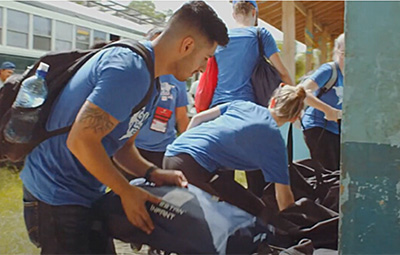An answer to the medical supply shortage issue: Auto-substitution
Supply chain disruptions will not end just because COVID-19 has.

Even now that the World Healthcare Organization has officially declared an end to the COVID-19 pandemic, the prospects of a medical supply shortage still remain very real for hospital administrators should a disruption occur for any number of other reasons—from manufacturing delays to natural disasters. With these disruptions come backordered products and wasted staff time manually chasing down their substitutes.
But through auto-substitution, Medline is helping hospitals avoid medical supply shortage disruptions and the worker time this entails. The program is designed to ensure that clinically approved substitutes for high-need medical supplies automatically get to a hospital’s dock, supply rooms, and most importantly, into the hands of clinicians who need them.
“A factor the medical supply chain is dealing with beyond the medical supply shortage is the impact this has on the deployment of people and staff,” says David Kordik, Vice President of Sales Operations for Medline. “One of the primary benefits of auto-substitution is time savings, which is every bit as important to customers as the flow of product because they’re so stretched in so many ways.”
Auto-substitution: a shift from reactive to proactive
The auto-substitution program is offered to IDNs that use Medline as their primary distributor and involves prework on two fronts:
- On the product side, Medline’s prime vendor analysts (PVAs) work with supply chain managers to identify critical items and their potential substitutes that must then be clinically preapproved by the health system.
- On the technology side, Medline works with the health system’s IT team to make sure both sides’ ERP (enterprise resource planning) systems are communicating with one another by standardizing EDI (electronic data interchange) transactions. “This is technology that exists today but isn’t widely used in healthcare as much as we would like to see,” Kordik explains. “It involves a little upfront work and testing, but the added benefit is that the procure-to-pay process between Medline and its health system partners remains whole and intact throughout the auto-substitution process.” (If a health system’s IT Department has too much underway to take on such a project, Medline can still set up auto-substitution manually. “We can provide data of restock items in a report that’s very specific so that their buyers can go in and manually make the changes they have to,” Kordik says.)
“What we’re doing is shifting the work from reactive to proactive,” Kordik says. “The same work still has to get done, but we’re doing it faster and eliminating the disruption.”
Needless to say, for this to work, medical supplies that have been identified for auto-substitution must be available in a Medline branch. This means validating that a substitute item requested by a customer is a viable option and making sure there’s a first, second and third choice. Medline’s PVA team tracks these on a daily basis and should a backup not be available for some reason, they notify the customer that other options need to be considered.
“It’s an ongoing process and part of the service we offer customers,” says Robert Brandt, Senior Director of Sales Administration for Medline. “You can never just make a substitution list and think you’re done. Supply chain and product variances happen all the time, so one of the things our PVA team does is proactively look out for any upcoming shortage in medical supplies.”
A niche benefit
Medline is using auto-substitution to the customer’s advantage in niche ways as well. For customers that have a 3PL (third-party logistics) agreement or post-pandemic product on hand, Medline uses these as a backstop should a hospital run out of an original item. Medline also uses auto-substitution to support ReNewal reprocessing items. “Customers typically want these items, but if we happen to run out of a given item, we can substitute it with one from an OEM (original equipment manufacturer) until the reprocessed item comes back,” Brandt says.
Wasted time—what happens without auto-substitution
Proactively identifying items ahead of time that could encounter supply problems is not new to supply chain management. The challenge comes when a backorder hits and the subsequent manual work and time involved acting upon the backorder even when a plan is in place—reviewing backorder reports, finding all the lines containing the backordered item, going into the system and manually updating it, and then confirming with the customer what they want to do.
Add to that the fact that when a primary SKU is on backorder, it’s not just one hospital trying to get the substitute. “Every hospital in that Medline branch that uses the product is now looking for a substitute,” Brandt says. “There’s a lot of time wasted, and the more time we waste, the less chance we have to get that product shipped on time.”
The biggest benefit to auto-substitution, Kordik says, is that it eliminates the whole manual process, which can take hours. It becomes spontaneous, and it occurs in real time. “It happens when the order hits our system, so if a substitute is there, it can be picked, packed and shipped on time. From an unadjusted fill rate perspective, we’re seeing an average 2, 3 or 4 percentage points in improvement.”
“One of the primary benefits of auto-substitution is time savings, which is every bit as important to customers as the flow of product because they’re so stretched in so many ways.”
David Kordik
Vice President of Medline Sales Operations
Results—customers see auto-substitution working
Medline’s auto-substitution program currently is in place in more than 20 IDNs across the country and continues to expand. Customers say the biggest impact on time and cost savings they see relates to the manual replacement process involved were they not using auto-substitution.
Take, for example, a customer service representative who spends an average 5 minutes per substituted line cancelling and then manually replacing that line on a new order.
- For a customer that “subs out” 20 lines per day, auto-substitution would save more than 90 minutes a day of a customer service representative’s time he or she would otherwise spend simply keying in the cancellation of the original line and placing a new order for the substitute item. This also delays getting product out in a timely manner and, possibly, shipment by one day, depending on timing.
- Also, a minimum one to two hours a day is saved in phone calls between the customer service representative and the hospital researching, discussing and approving substitute items if an account does not have a preapproved list.
“It’s another way we’re helping health systems build resiliency into their hospital operations,” Kordik and Brandt say. “Supply chain teams are spending so much time today chasing down backorders and calling vendors. Now, they can work with the Medline distribution team to come up with a known plan and a standardized list of clinically approved substitutes for items that might be in trouble that everyone agrees on. There’s a sense of control and confidence that comes with that.”




